April 2 – April 8, 2021:
On Thursday, April 8, Iran broke its official record for new coronavirus infections for the third day in a row, with 22,586 new cases confirmed in a 24-hour period.
The surge follows the end of the long Iranian New Year holiday, which started on March 21 and saw millions of Iranians travel and visit one another to attend festivities, in the absence of an all-out ban from the government.
The more recently-detected variants of SARS-CoV-2 continue to run rampant in Iran. Hospitals across the country are dealing with a rapid increase in inpatients, with 1,000 people now being admitted to hospital every day in Tehran province.
The situation in other provinces is no better. More than 85 percent of cities in Iran are now on red or orange alert for coronavirus transmission. There are also reports that the variant first detected in Brazil has emerged in Khuzestan province.
In the same period, Iranians have received no useful or important news about Iran’s tentative vaccination drive, which is now more important than ever.
Doubts about Domestic Vaccine
Iran’s Food and Drug Administration is responsible for approving both foreign-made and domestic Covid-19 vaccines. This week, the agency’s spokesman, Kianoush Jahanpour, tweeted blandly that Iranian vaccines were a “national honor”.
Another Twitter user commented that she had no problem with Iranian vaccines, but they needed to be approved by reputable international organization. In response, the former Health Ministry spokesman tweeted back: “You don’t have to get it. It’s not compulsory.”
Last winter the Islamic Republic launched a bloated propaganda campaign to promote its domestically-made coronavirus vaccines, including Coviran-Barekat, which is made by a parastatal conglomerate under the control of the Supreme Leader.
But since then, the date for these vaccines’ beginning to be administered to the public has been pushed back further and further by officials. Initially it had been promised that Iranian-made vaccines would be ready for use by late May 2021. Now, mass inoculations have been postponed until September.
Tehran Hospitals Running out of Beds
Dr. Nader Tavakoli, deputy director of Tehran Coronavirus Taskforce, warned that for three days straight more than 1,000 Covid-19 patients had been hospitalized in greater Tehran. The trend, he said, was continuing, and was clear evidence of a “fourth wave” of infections in Iran.
In total, some 5,400 people with Covid-19 are currently being treated in hospitals in Tehran province. Dr. Alireza Zali, director of Tehran’s Coronavirus Taskforce, also reported that some 300 people with Covid-19 in Tehran were having to wait on emergency wards for hospital beds to become available.
He described the new surge of infections as “complicated and dangerous” and reported that, except for three small towns, every city in the province is now on red alert. For her part Dr. Minoo Mohraz, a member of the National Coronavirus Taskforce, described the situation in Tehran as “black” and said the highly contagious coronavirus variant first detected in Britain was responsible for the recent rise in fatalities.
The Iranian Health Ministry has announced that non-essential businesses must close in all of the 257 cities currently on red alert. Tehran’s great bazaar will go into lockdown for two weeks starting on Saturday, April 10. In a number of other provinces including Gilan and Fars, Friday prayers have also been suspended in all cities until further notice.
Official Coronavirus Statistics
According to the official statistics announced daily by the health ministry’s spokeswoman Dr. Sima Sadat Lari, a total of 1,125 patients were registered as having lost their lives to Covid-19 in the week ending April 8.
By the week’s end, 4,221 Covid-19 patients were also being treated in ICUs.
Dr. Lari also reported that 257 cities in Iran are now on red alert and 129 are classed as orange. According to a decision by the National Coronavirus Taskforce’s, traveling from and to red and orange cities is banned. The number of cities on yellow alert is currently 51 and only 11 cities are on “blue”, the lowest coronavirus alert level.
One Hospitalization Every Nine Minutes in Kermanshah
In the 24 hours before noon on April 8, one Covid-19 patient was hospitalized every nine minutes in Kermanshah, reported Mehdi Mohammadi, a spokesman for Kermanshah University of Medical Sciences. He added that the number of inpatients in hospitals run by this university had now climbed to 527, of whom 156 were hospitalized in the past 24 hours.
Mohammadi also said that more than 30 percent of coronavirus tests recently conducted in Kermanshah have been positive and this ought to “sound the alarm” for the whole province. The new surge in infections, he said, has just begun and is unlikely to “peak” for some time.
A New Coronavirus Variant in Khuzestan?
Khuzestan was hit by the coronavirus variant first discovered in Britain a few weeks before the rest of Iran. The situation in the province is still being described as “dangerous”. In the assessment of Dr. Mohammad Alavi, president of Khuzestan Health Center, every city in the province – regardless of the official alert level – is in the “danger zone”.
“We cannot immediately increase hospital beds,” he said, “and the University of Medical Sciences has gone to incredible trouble to convert regular beds to specialized beds for Covid-19 patients.”
In the western zones of the provincial capital of Ahvaz, out of every 600 coronavirus tests conducted, around 50 percent have been positive. Ghasem Soleimani Dashtaki, Khuzestan’s governor, said it is likely that the coronavirus variant first detected in Brazil has now entered the province. He emphasized that the borders between Khuzestan and Iraq are still closed and foreign travelers cannot enter Iran through this province.
Field Hospitals in Qazvin
Qazvin was one of the main transit points for travelers during Nowruz, the Iranian new year’s holidays, and this has fueled a new surge in coronavirus infections. In just 24 hours before noon of April 8, four Covid-19 patients died and around 100 new patients were hospitalized.
Manouchehr Habibi, director of Qazvin Coronavirus Taskforce, announced that a set of new two-week restrictions had been imposed on the province and reported that the army is setting up a field hospital in Qazvin to treat the overflow of Covid-19 patients. Six of the seven counties in Qazvin are now on red alert.
Tragic Family Gathering in Hormozgan
In the southern province of Hormozgan, a favourite destination of travelers in late winter and early spring, six cities have been put on red alert and three on orange alert.
An official of Hormozgan University of Medical Sciences reported that all six participants in a family gathering had been infected with coronavirus, and the mother had since died from Covid-19.
The latest official statistics state that as of now Covid-19 has claimed 1,067 lives in Hormozgan: a figure likely to be several times short of the real number.
April 9 – April 15:
On the last day of the week ending April 15, the officially-recorded death toll from Covid-19 in Iran stood at 321, a record-breaking figure for a single day. The health minister has warned that the situation will get worse in the coming week.
According to local officials, more than 50 percent of people taking PCR swab tests in some provinces are returning a positive result. This includes Tehran province, where, according to Dr. Alireza Zali, director of Tehran Coronavirus Taskforce, all cities have now been put on red alert at once for the first time.
Confusion still swirls around Iran’s planned vaccination program. This week, President Rouhani said that “despite all efforts” it is unlikely that a domestic vaccine will become available before the summer, and as such, “the government has been given priority to acquiring vaccines with the help of the private sector.”
In the midst of the fourth wave of coronavirus in Iran, according to the World Health Organization, just 200,000 doses of vaccine have so far been administered within a population of 84 million.
Iran has meanwhile imposed a travel ban on 39 countries, announced Minister of Roads and Urban Development Mohammad Eslami on April 11. He added that Iranian travel agencies must comply with the National Coronavirus Taskforce’s regulations banning any land trips to and from Turkey, even though flights between the two countries are continuing as normal.
As-Yet Unannounced Restrictions on Ramadan Events
The holy month of Ramadan, during which Muslim are expected to fast, pray and reflect, began this week. Health Minister Saeed Namaki had earlier said that there would be no restrictions on Ramadan religious ceremonies. This week, with Covid-19 figures again on the rise, he clarified that events to mark Laylat al-Qadr, which commemorates the night when Quran was first sent down from Heaven to the Prophet Mohammad, must follow the official health protocols.
According to President Rouhani, however, the protocols for Ramadan ceremonies will only be announced once they have been approved by the National Coronavirus Taskforce. “Under the current conditions,” he said, “our main strategy is to protect people’s lives and health. The protocols will be written in a way that protects people’s lives while they participate in these rituals.”
New Deal to Buy Russian Vaccine – Sometime This Year
Iran has finalized a deal with Russia to purchase 60 million doses of the Sputnik V vaccine, the Islamic Republic News Agency (IRNA) reported on Thursday, April 15. The report quoted Iran’s ambassador to Russia, Kazem Jalali, as saying a contract for enough vaccinations to inoculate 30 million people had been “signed and finalized”. But Jalali added that Iran will receive the vaccines “by the end of the year”, which is a long time away.
Meanwhile the first shipment of vaccines from COVAX, an international collaboration led by the World Health Organization (WHO) to deliver vaccines equitably across the world, arrived in Iran on Monday, April 12 from the Netherlands, containing 700,000 doses of Oxford-AstraZeneca.
Also on April 15, some 400,000 doses of the Chinese-made Sinopharm vaccine, donated by the Chinese Red Cross, were delivered to Iran by air. Three days earlier, China’s top disease control specialist had admitted that Chinese vaccines currently offer low protection against Covid-19. A few hours later, he backpedaled, publicly qualified his statement and said it had been a “misunderstanding”.
As mentioned above, President Rouhani has said it is unlikely a domestically-produced vaccine will become available before the summer. But on April 15, Health Minister Saeed Namaki contradicted him, stating that “within 20 days” vaccination will expand in Iran using both domestic and imported products.
On the same day, the Razi Vaccine and Serum Research Institute said mass production of its Cov-Pars Covid-19 vaccine would begin in late August. Just a day earlier Kianoush Jahanpour, spokesman for Iran’s Food and Drug Administration, had claimed that five countries including two European countries had so far asked about purchasing the Iranian-made vaccine.
According to the Ministry of Health, among the more than 12 different firms in Iran that are attempting to produce a vaccine, five companies have so far surpassed the rest. These include the companies involved in the production of a joint vaccine with Cuba in Pasteur Institute, which is set to be mass-produced later this spring.
New Alert Levels: “Black” and “Super-Red”
With the sharp spike in coronavirus infections and fatalities, the Iranian Ministry of Health has added two new alert levels, “black” and “super-red”, to its system for classifying the level of threat posed by the virus in different location. According to the new criteria, 63 cities are currently “black”, 85 are super-red, 176 are red, 78 are orange, 39 are yellow, and seven are blue, the lowest possible alert level until the pandemic is over.
Official Coronavirus Statistics
According to the official statistics announced daily by the health ministry’s spokeswoman Dr. Sima Sadat Lari, a total of 1,796 patients lost their lives to Covid-19 in the week ending April 15. With 321 deaths, April 15 recorded the highest number of fatalities on a single day, in a week that witnessed a record-breaking number of officially-recorded daily deaths from Covid-19.

At the week’s end, 4,601 Covid-19 patients were being treated in ICUs.
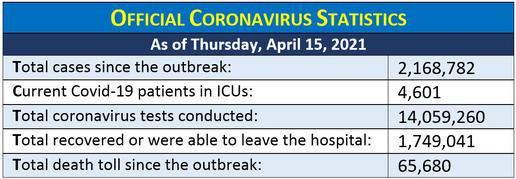
In her latest briefing, Dr. Lari followed the old alert level classification and reported that 295 Iranian cities were on red alert, 99 were orange, 45 were yellow and only nine were blue. No reason was given for the discrepancy in classification and numbers.
April 16 – April 22:
On Thursday, April 22, the official number of daily Covid-19 fatalities in Iran passed 450 for the first time in 2021.The jump in the number of new cases has not only coincided with a shortage of hospital beds in both common wards and ICUs, but a shortage of equipment and facilities.
Tehran’s Masih Daneshvari Hospital is a well-known center for treating patients with acute respiratory diseases. But this facility, too, is now at capacity, and has set up a field hospital in its grounds.
The fourth wave of coronavirus has also led to a shortage of medical manpower. On April 22, Health Minister Saeed Namaki ordered that all students in their final year of medical, nursing and medical assistant courses must report to wards treating Covid-19 patients.
Joint Production of the Russian Vaccine
Namaki also announced that joint production of the Russian Covid-19 vaccine Sputnik V will get under way in Iran in the next two weeks. He claimed that by late May, Iran would rank among the “best” producers of coronavirus vaccine in the world.
On April 22, Iran also received a delivery of 100,000 more doses of Sputnik vaccine. This is the sixth shipment of the Russian vaccine to Iran and brings the total number of doses to 620,000, enough to vaccinate 310,000 people.
The Islamic Republic reports that so far it has imported a total of 2.95 million doses of vaccine: a very low number compared to other countries in the region. Since vaccination began in Iran two months ago, just 667,202 doses have been administered while in Turkey, Iran’s northwestern neighbor, which has a comparable population, more that 20 million doses have been given to patients.
Cash for Vaccinations?
Besides the slow pace of Iran’s mass vaccination drive, there have been persistent reports that preferential treatment is playing a role. Some municipal officials, Friday Imams and members of their families have been inoculated in instances of alleged queue-jumping.
On Sunday, April 18, Alireza Raeesi, spokesman for the National Coronavirus Taskforce, said that while all Iranians should have been vaccinated for free by March 2022, citizens who want to received the jab ahead of their officially-prescribed turn can “pay for the expenses” and do so.
The next day, however, he retracted his statement and announced instead “all groups in the country will receive free coronavirus vaccination in order of priority”.
Official Coronavirus Statistics
According to official statistics announced daily by the health ministry, a total of 2,686 patients lost their lives to Covid-19 in the week ending April 22. With 453 deaths, April 22 had the highest number of officially-recorded fatalities for the week. The highest number of Covid-19 fatalities in a single day since the pandemic started, 468, was logged on November 16, 2020.
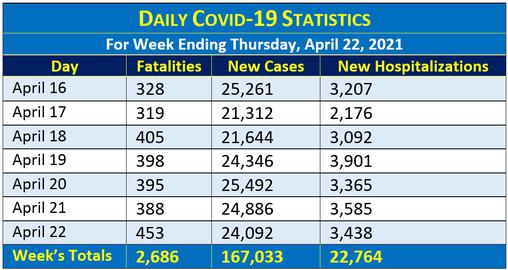
At the week’s end, 5,038 Covid-19 patients were being treated in ICUs.
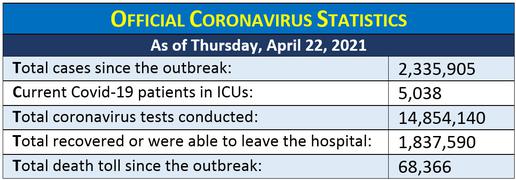
At the week’s end the health ministry announced that 301 Iranian cities are currently on red alert, 95 are orange, 45 are yellow and only seven cities are on blue alert.
Provinces Round-up
Due to the unprecedented surge in coronavirus infections, North Khorasan University of Medical Sciences has asked the third sector for help in acquiring the equipment and supplies it desperately needs, including, but not limited to, at least eight ICU beds, surgical masks and PPE, disinfectants and 70-percent pure alcohol. The university also published its bank account details so people can make direct donations.
Dr. Mohammad Arezumand, president of Amir al-Mo’menin Hospital in Ahvaz, the capital of Khuzestan province, reported that the hospital had completely run out of beds even on its emergency ward. The number of outpatients, he said, continued to rise. According to him, 70 percent of the hospital’s medical staff and health workers have been infected with coronavirus since the pandemic started and one has died but “fortunately” now almost all its frontline health workers have been vaccinated.
This hospital is not the only one in Khuzestan that has been overwhelmed by the recent fresh surge in Covid-19 patients. Dr. Farhad Soltani, vice president of Ahvaz Jondishapur University of Medical Sciences, reported that coronavirus wards in all cities of the province are at capacity and out of its close to 2,000 Covid-19 inpatients, more than 400 are being treated in ICUs.
In Tehran province, according to Behesht Zahra Cemetery, the number of daily coronavirus fatalities has reached 150 and the crisis shows no sign of easing. Dr. Alireza Zali, director of Tehran Coronavirus Taskforce, reported that 35 percent of Covid-19 patients currently being treated in ICUs across this province are in a grave condition.
He added that some 8,572 Covid-19 patients were hospitalized in 105 hospitals in Tehran province, around 2,000 of whom were in intensive care units. On Wednesday, April 21 alone, 1,990 new patients were hospitalized while the number of newly-logged outpatients stood at around 16,000. Dr. Zali said that restrictions and lockdowns must continue and called for a “support package” for people who those in a dire economic situation.
In East Azerbaijan, 1,606 Covid-19 patients are in hospital, eight percent higher than on the worst day of the “third wave” last November, reported Dr. Mohammad Sumi, president of Tabriz University of Medical Science. He added that in the past 24 hours 23 Covid-19 patients died whereas just a month ago the number of fatalities was down to at most one per day. As of now, 4,345 inpatients are known to have lost their lives to Covid-19 in this province.
Dr. Abbas Ali Dorosti, vice president of the same university, warned that with the increase in hospital admissions, these facilities are in danger of running out of oxygen which is essential for treating Covid-19 patients with severe respiratory symptoms.
This is part of IranWire's coronavirus chronology. Read the full chronology
visit the accountability section
In this section of Iran Wire, you can contact the officials and launch your campaign for various problems




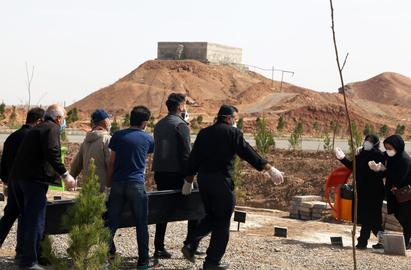




















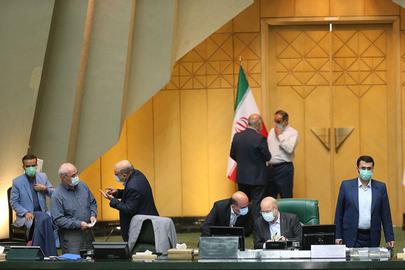
comments